I started taking fencing lessons five years ago, a neophyte to its beauty and tradition. What an elegant and civilised ritual of redress, and how perfectly Errol personified this on screen.
Sadly, real fencing is not nearly as graceful or enthralling. The position of the body is different, the silhouette less pleasing. I was asked why I held my left arm behind me? ‘I’m copying Errol,’ I replied. (See his left hand as he duels in ‘The Sea Hawk’, below.)
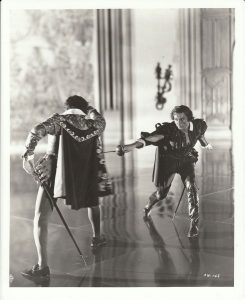
There was a moue of distaste from my teacher:’ Your left arm should be in a sideways position, and the hand should hang forward, as if you were resting it over a stool.’ Swordplay in films, he went on, is ‘incorrect.’ It is ‘overly broad and filled with anachronistic and idiotic techniques.’
I gave up my fencing lessons in the face of such unromantic realism and myopia. To compare film fencing with real life fencing is like comparing a Rembrandt with Instagram.
Film fencing is designed to create a beautiful and exciting effect. And when it is done well, that itself is enough. Nonetheless, the greatest celluloid fencers knew what they were doing, and some studied under masters. A certain amount of technique was a requisite.
There has already been some debate amongst us Flynnsters as to whom was the greater fencer – Errol, Basil Rathbone or, principally because of the climactic duel in ‘Scaramouche,’ Stewart Granger?
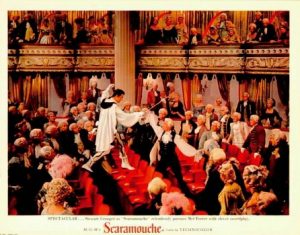
If the duels had been real, Basil Rathbone would have killed Errol and Granger, probably at the same time. (Rathbone could have fenced professionally and was taught by both Felix Grave and Leon Bertrand.) He knew how good he was, and once remarked that though Errol would always get the girl, he would always be able to skewer Errol through the heart.
‘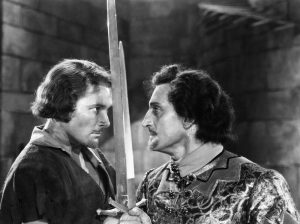
But let’s not forget Ronald Colman and Douglas Fairbanks Jr in the first and best film version of ‘The Prisoner of Zenda’ (1937). Like his father, Doug Jr had a wonderful insouciance and agility that made him a mesmerising swordsman on film. Ronald Colman is equally good in a ‘quieter’ fashion.
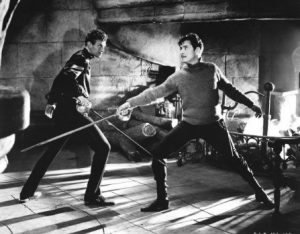 Doug Fairbanks Jr and Ronald Colman in ‘The Prisoner of Zenda.’
Doug Fairbanks Jr and Ronald Colman in ‘The Prisoner of Zenda.’
Then there was Robert Donat, whose whole look and style was curiously similar to Errol’s. He was even intended for the lead in ‘Captain Blood.’
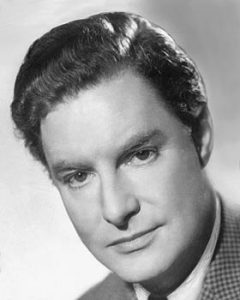
Donat was a beautiful actor and a beautiful man. But, like Errol he was prone to illness from a relatively young age. Alexander Korda, who discovered him, used to send Donat to a London specialist, who also treated my grandmother. Donat had chronic asthma and could not complete action scenes, though he uses a sword very gracefully in ‘The Count of Monte Cristo’ (1934), and sometimes whole films had to be halted.
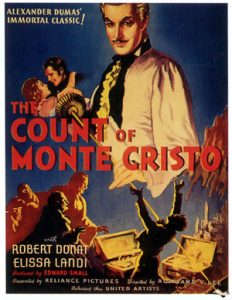
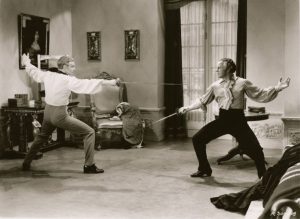
Also noteworthy, though of a different era, is Daniel Auteil in ‘Le Bossu’, a 1990s film that revives the traditions of the swashbuckler. Auteil’s duelling is highly dramatic, particularly when he executes a secret and lethal manoeuvre called the ‘Nevers Attack.’
Yet there is one major star we haven’t mentioned as a nominee for the title of greatest film fencer. And it may be a glaring omission. This actor is of a similar vintage to Errol and Stewart Granger and is deceased. So let’s have some fun and try and guess who he was. In esse, this is a quiz question. Clues below.
Clue 1: Basil Rathbone said he was the greatest fencer he had ever worked with in his entire film career, remarking, ‘after a few weeks of instruction, he could completely outfight me!’
Clue 2: The man in question was not known for playing swashbuckling roles.
Clue 3: He reached the peak of his fame in the 1950s. His co-stars, aside from Rathbone, included Paul Henreid, Boris Karloff and Yul Brynner. Leading ladies included Gene Tierney and Barbara Bel Geddes.
Clue 4: He often performed on stage.
Clue 5: Women’s hats.
— PW

Surely you jest, PW! This fine faking fellow would have sprinted back to Mrs. Kaminsky’s in East New York if he ever saw Errol Flynn coming at him with a sword!
[img]http://www.mp3million.com/photo/0056647/Danny%20Kaye.jpg[/img]
[img]http://www.theerrolflynnblog.com/wordpress/wp-content/uploads/2017/02/image-5.jpg[/img]
As far as swordbuckling goes we’d have to fence Tyrone Power in. As far as your jestquestion is concerned, I too opt for Courty K.
You are both far too clever for me. Yes ,of course it was Danny Kaye. And if Rathbone said he was the best, that’s good enough for me, though I would much rather watch Errol. Rathbone did add that he put Courty K’s incredible skill down to his gift for mimicry and dancing. Now, let’s see if either of you can tell me precisely what the ‘Nevers Attack’ consisted of. I will give you 12 hours before I throw down my own gauntlet!
Too clever for you, Petsy!? That will certainly never be true!! Nor will your sparkling wit, charm and intellect ever be fenced in.
By the way, loved the account of your fencing adventures. Good for you being on guard and standing your ground! Flynn would be very proud of you. His “Flynning” transformed and enormously popularized fencing, as did his archery in Robin Hood. And Basil was so tremendous at blending his formal and cinematic fencing skills, the perfect foil for Errol, but he would never give Flynn the credit he deserved for his magnificent fencing on film.
youtu.be/A7DCG2nnMvU…
Speaking of nevers, I believe you may be referring to the story of Lagardiere and the Duke of Nevers, told in On Guard, which I have never seen.
[img [/img]
[/img]
“Lagardère who is befriended by the Duke of Nevers. When the duke is attacked by his evil cousin Gonzague, the duke in his dying moments asks Lagardère to avenge him and look after his infant daughter.”
Poor Basil never stood a chance:
[img [/img]
[/img]
[img]http://www.theerrolflynnblog.com/wordpress/wp-content/uploads/2017/02/framebaz.jpg[/img]
Dear Baz was no push- over, Saberman Tim. I always found if not for the energetic emergence of Errol, Basil Rathbone would have made for a terrific Robin Hood. Not quite as handsome as other matinee idols, but with much personality, authority and a nose like no other. I liked him very much his Sherlock Holmes movies. If he had donned the green tights, who could have played Sir Guy of Gruesome? Any suggestions, Flynn folks!?